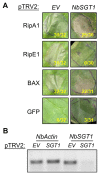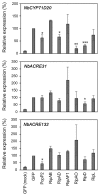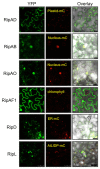Ralstonia solanacearum Type III Effectors with Predicted Nuclear Localization Signal Localize to Various Cell Compartments and Modulate Immune Responses in Nicotiana spp
- PMID: 32089660
- PMCID: PMC7012579
- DOI: 10.5423/PPJ.OA.08.2019.0227
Ralstonia solanacearum Type III Effectors with Predicted Nuclear Localization Signal Localize to Various Cell Compartments and Modulate Immune Responses in Nicotiana spp
Erratum in
-
Erratum: Ralstonia solanacearum Type III Effectors with Predicted Nuclear Localization Signal Localize to Various Cell Compartments and Modulate Immune Responses in Nicotiana spp.Plant Pathol J. 2020 Jun 1;36(3):303. doi: 10.5423/PPJ.ER.08.2019.0227. Plant Pathol J. 2020. PMID: 32547346 Free PMC article.
Abstract
Ralstonia solanacearum (Rso) is a causal agent of bacterial wilt in Solanaceae crops worldwide including Republic of Korea. Rso virulence predominantly relies on type III secreted effectors (T3Es). However, only a handful of Rso T3Es have been characterized. In this study, we investigated subcellular localization of and manipulation of plant immunity by 8 Rso T3Es predicted to harbor a nuclear localization signal (NLS). While 2 of these T3Es elicited cell death in both Nicotiana benthamiana and N. tabacum, only one was dependent on suppressor of G2 allele of skp1 (SGT1), a molecular chaperone of nucleotide-binding and leucine-rich repeat immune receptors. We also identified T3Es that differentially regulate flg22-induced reactive oxygen species production and gene expression. Interestingly, several of the NLS-containing T3Es translationally fused with yellow fluorescent protein accumulated in subcellular compartments other than the cell nucleus. Our findings bring new clues to decipher Rso T3E function in planta.
Keywords: Nicotiana spp.; Ralstonia solanacearum; bacterial wilt; innate immunity; type III effectors.
© The Korean Society of Plant Pathology.
Figures





Similar articles
-
The large, diverse, and robust arsenal of Ralstonia solanacearum type III effectors and their in planta functions.Mol Plant Pathol. 2020 Oct;21(10):1377-1388. doi: 10.1111/mpp.12977. Epub 2020 Aug 8. Mol Plant Pathol. 2020. PMID: 32770627 Free PMC article. Review.
-
Ralstonia solanacearum Effectors Localize to Diverse Organelles in Solanum Hosts.Phytopathology. 2021 Dec;111(12):2213-2226. doi: 10.1094/PHYTO-10-20-0483-R. Epub 2021 Dec 6. Phytopathology. 2021. PMID: 33720750
-
Diverse interactions of five core type III effectors from Ralstonia solanacearum with plants.J Genet Genomics. 2023 May;50(5):341-352. doi: 10.1016/j.jgg.2022.04.018. Epub 2022 May 18. J Genet Genomics. 2023. PMID: 35597445
-
Molecular chaperons and co-chaperons, Hsp90, RAR1, and SGT1 negatively regulate bacterial wilt disease caused by Ralstonia solanacearum in Nicotiana benthamiana.Plant Signal Behav. 2015;10(6):e970410. doi: 10.4161/15592316.2014.970410. Plant Signal Behav. 2015. PMID: 25482800 Free PMC article.
-
Breeding for resistances to Ralstonia solanacearum.Front Plant Sci. 2014 Dec 12;5:715. doi: 10.3389/fpls.2014.00715. eCollection 2014. Front Plant Sci. 2014. PMID: 25566289 Free PMC article. Review.
Cited by
-
The Ralstonia pseudosolanacearum effector RipE1 is recognized at the plasma membrane by NbPtr1, the Nicotiana benthamiana homologue of Pseudomonas tomato race 1.Mol Plant Pathol. 2023 Oct;24(10):1312-1318. doi: 10.1111/mpp.13363. Epub 2023 Jun 13. Mol Plant Pathol. 2023. PMID: 37310613 Free PMC article.
-
The disordered effector RipAO of Ralstonia solanacearum destabilizes microtubule networks in Nicotiana benthamiana cells.Mol Cells. 2025 Jan;48(1):100167. doi: 10.1016/j.mocell.2024.100167. Epub 2024 Dec 5. Mol Cells. 2025. PMID: 39645148 Free PMC article.
-
Ubiquitin E3 ligase activity of Ralstonia solanacearum effector RipAW is not essential for induction of plant defense in Nicotiana benthamiana.Front Microbiol. 2023 May 24;14:1201444. doi: 10.3389/fmicb.2023.1201444. eCollection 2023. Front Microbiol. 2023. PMID: 37293211 Free PMC article.
-
A bacterial type III effector targets plant vesicle-associated membrane proteins.Mol Plant Pathol. 2023 Sep;24(9):1154-1167. doi: 10.1111/mpp.13360. Epub 2023 Jun 5. Mol Plant Pathol. 2023. PMID: 37278116 Free PMC article.
-
Identification of RipAZ1 as an avirulence determinant of Ralstonia solanacearum in Solanum americanum.Mol Plant Pathol. 2021 Mar;22(3):317-333. doi: 10.1111/mpp.13030. Epub 2021 Jan 3. Mol Plant Pathol. 2021. PMID: 33389783 Free PMC article.
References
-
- Choi S, Jayaraman J, Segonzac C, Park H-J, Park H, Han S-W, Sohn KH. Pseudomonas syringae pv. actinidiae type III effectors localized at multiple cellular compartments activate or suppress innate immune responses in Nicotiana benthamiana. Front Plant Sci. 2017;8:2157. doi: 10.3389/fpls.2017.02157. - DOI - PMC - PubMed
-
- de Lange O, Schreiber T, Schandry N, Radeck J, Braun KH, Koszinowski J, Heuer H, Strauß A, Lahaye T. Breaking the DNA-binding code of Ralstonia solanacearum TAL effectors provides new possibilities to generate plant resistance genes against bacterial wilt disease. New Phytol. 2013;199:773–786. doi: 10.1111/nph.12324. - DOI - PubMed
LinkOut - more resources
Full Text Sources
Miscellaneous

